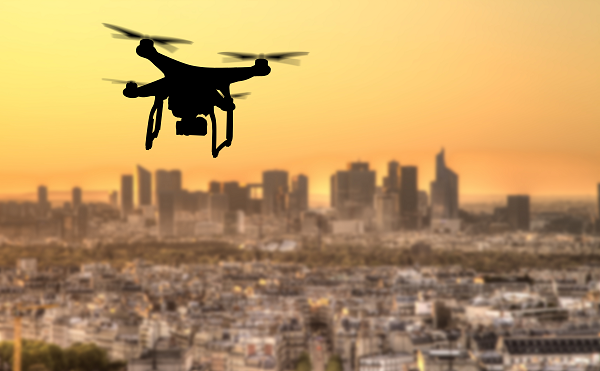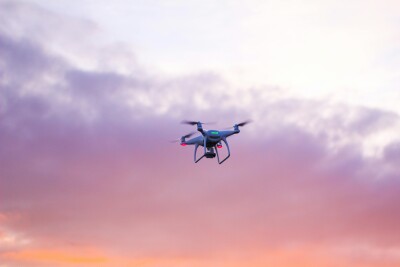Every day, drones improve lives, optimize operations, and transform societies. But a small portion of drone operators cause chaos, endanger lives, and pose a threat to safety and national security globally.
In this interview former British military officer and current UK Managing Director for D-Fend Solutions, Martin Broomhead, provides his unique  perspective on counter-UAS challenges for today’s urban and sensitive environments in the UK and beyond. He explains how D-Fend Solutions’ EnforceAir, the company’s flagship precision and cyber-based drone detection, identification, tracking, and mitigation solution, helps a wide range of government and industry customers achieve “proportional policing”—a balanced approach to confront the ever-changing drone threat. Time and battle-tested (literally and figuratively), customers around the world have deployed EnforceAir in its various configurations to safely take over rogue drones and land them in a predefined zone with pinpoint accuracy.
perspective on counter-UAS challenges for today’s urban and sensitive environments in the UK and beyond. He explains how D-Fend Solutions’ EnforceAir, the company’s flagship precision and cyber-based drone detection, identification, tracking, and mitigation solution, helps a wide range of government and industry customers achieve “proportional policing”—a balanced approach to confront the ever-changing drone threat. Time and battle-tested (literally and figuratively), customers around the world have deployed EnforceAir in its various configurations to safely take over rogue drones and land them in a predefined zone with pinpoint accuracy.
Read on to learn more about drone incidents, airspace safety issues in the UK and around the globe and how D-Fend Solutions continues tackling the toughest counter-UAS issues.
Dawn Zoldi: Martin, first tell us a bit about your background. You bring an interesting perspective to the table.
Martin Broomhead: I come from an aviation background that includes 25 years in the military. I flew helicopters for the British Army during that time. I know what it's like to be in an aircraft and the risks to air safety from a mid-air collision.
Dawn Zoldi: There's been just such an incredible proliferation of drones globally. What drone use cases are you seeing in the UK?
Martin Broomhead: That's a great place to start. D-Fend Solutions comes very much from a position that drones are here and they're here for the good of society. Under current projections, in the UK alone there's expected to be over 76,000 commercially flown drones by 2030. The majority of users will be in the public and defense sector, health education and other services. We also expect to see agriculture, mining, gas and electricity industries continue being big drone adopters. Transport and logistics will rank in the top three. Of course, drone use in construction, manufacturing, media, and other services will also continue to grow. For all these drones-for-good operations to occur, we need to protect against the illegal use of drones by taking illegal actors out of the picture. All these legitimate drone users need to be able to operate safely.
Dawn Zoldi: That’s a great segue to talk about some of the troubling trends you have seen, in terms of airspace safety. Tell us about that.
Martin Broomhead: In the airspace, we are seeing drone incidents happening not just near to ground level, up to four to five hundred feet, but near misses with passenger-carrying airliners up to 16,000 feet. For example, recently Edinburgh airport had to ground flights because they had a drone flying near ground level. Conversely, there was a plane that had to take avoiding action when it came within three meters of a drone at sixteen thousand feet. That just gives you a broader context of the scope and danger of illegal drone flights within airspace.
Dawn Zoldi: Besides the harassment of crewed aviation in the air, you’ve also seen drone incursions at airports, right?
Martin Broomhead: Yes, illegal drone flights at airports remain a big concern. Airport traffic needs to operate safely. We need a policing structure to deal with any nefarious, rogue or malfunctioning drones within flight lanes. A watershed moment for the UK and for drones in particular was Gatwick.
Dawn Zoldi: How could D-Fend Solutions have helped to flip the script during such an airport incident?
Martin Broomhead: That event happened over several days and cost the airlines and airport industry millions of pounds. Had EnforceAir been used in such a scenario, that incident could have been dealt with much quicker. We would have expected the system to have detected the drone immediately. We would expect the system to be able to tell the authorities where the pilot was located, and they could have dealt with him or her. This is what we call proportional policing. Rather than a huge security operation that shuts down an airport and everything that flows from that, such incidents as these could be dealt with quickly and quietly in the background. That’s ultimately the aim of any security operation.
Dawn Zoldi: You’ve also tracked other publicly reported drone incidents in the news in the UK, such as the drone that was used in an attempt to smuggle contraband into a jail last summer. How would EnforceAir work in such a situation?
Martin Broomhead: Smuggling contraband into prisons and the underground economy within the prison is a huge business. Take, for example, SIM cards. In the UK, they are worth two thousand pounds each in a prison. You can see why criminals are driven to get such contraband across the fence. Drones have proved an extremely lucrative way of doing that. Imagine how many tiny mobile SIM cards you can fit on a drone.
With a system like EnforceAir in place, security staff would be able to detect those drones immediately and tell you where the pilot is. It all goes back to proportional policing. It’s about arresting the perpetrator at source. It’s one thing to capture the drone, but they'll just come back with another one. You want to stop the pilot to make it understood that this is no longer a viable way for them to smuggle contraband into a prison.
Dawn Zoldi: Besides prisons, stadiums and arenas seem to be a hot spot for illegal drone activities, wouldn’t you agree?
Martin Broomhead: Yes. There was a recent incident at a football (you call it soccer) event where an individual was trying to get his YouTube moment. He was flying the drone around the stadium during the game. There was a risk that if he crossed into the stadium with 90,000 people in it, he would have caused a major incident, possibly mass pandemonium. I unapologetically go back to proportional policing here.
Using our EnforceAir system, the operators were able to detect not only the drone but also where the pilot was located. In this case, the pilot had chosen to launch his drone, walk back into the car park and climb into his car. He probably thought it was safe to operate there without being detected. He was wrong. Within minutes of the report about the drone, there was a Police Officer knocking on his car window. The drone pilot was arrested, and the drone was confiscated. That's another great example where operators helped contain an incident through the use of our cutting-edge technology and prevented the need for a major security operation.
Dawn Zoldi: We’ve discussed a small handful of UK drone incidents in the news here, but is there a place where people can find out what incidents are happening globally?
Martin Broomhead: Absolutely. D-Fend Solutions’ website has a drone incident and attack tracker which shows publicly reported incidents in the news (https://d-fendsolutions.com/drone-incident-tracker/). Information in the Drone Incident Tracker is compiled from various public domain sources such as media and information providers such as DroneSec.
Dawn Zoldi: D-Fend Solutions created EnforceAir to address this wide spectrum of drone threats. Tell us more about the why and how of EnforceAir.
Martin Broomhead: Traditional counter UAS Solutions are often not suitable as the sole component of a counter UAS strategy. They can interfere with communications and authorized drones and cause collateral damage or even fail to detect the threat.
EnforceAir features radio frequency cyber takeover technology. It passively detects, locates and identifies rogue drones and their pilots and then actively mitigates the drone. EnforceAir can be set up and operational within 5 minutes. The hardware is compact and can be rapidly disassembled, moved and reassembled for operational flexibility. As soon as rogue drones enter a protected area, they are detected, and an alert is immediately activated. Their unique communication identifiers are obtained, and the takeoff location is discovered. EnforceAir's unique takeover technology can automatically take control of the drone. Authorized drones in the area are unaffected. The rogue drones are sent along their designated route, ending in a safe landing.
This safe outcome is achieved without disrupting the continuity of communications, commerce, transportation or everyday life. D-Fend Solutions constantly develops new capabilities to always stay a drone threat ahead. It’s been used by the military, public safety, airport, border patrols, for VIP escort, prison protection, during major events and in critical infrastructure environments. EnforceAir has been deployed hundreds of times worldwide.
Dawn Zoldi: You alluded to it, but can you explain the different configurations for EnforceAir that customers can deploy across the wide range of drone incidents?
Martin Broomhead: There are multiple ways that counter UAS capabilities can and should be employed, and they are situational. We have a directional antenna, a narrow cone with long range, ideal for situations along borders. In the UK this is used at airports. It stares down the runway and looks way out into the extended centerline to protect aircraft in those critical moments during takeoff and landing.
We also have the tactical system. This is particularly useful in a multitude of ways. It comes in three easily transportable cases that fit in the back of any small vehicle and become rapidly operational. Set up for this tactical unit can be as quick as three minutes, although five to ten minutes is probably typical.
We also have a covert vehicle deployment option. It can be fitted to and removed from any vehicle in about 10 minutes without any modifications to the vehicle. This is used for both mobile deployments in airports, such as protecting perimeters or moving to the area of an incident, as well as for convoy protection. We've seen it used widely for that across many areas globally.
Dawn Zoldi: You have this amazing tech, but are the regulations and laws keeping up in the UK to enable it? I ask because in the U.S., only certain federal agencies have the authority to both detect and mitigate drones, and a whole host of criminal laws inhibit the ability for local law enforcement to do the same.
Martin Broomhead: In the UK, have similar laws and regulations which were also put in place for good reasons but without considering that similar technologies would need to be used in the context of taking control of a drone. Just to list a few, we have the Computer Misuse Act, the Investigatory Powers Act, the Criminal Damage Act, the Aviation Maritime Security and the Civil Aviation Act. We also have The Navigation Order from OFCOM, an agency that governs frequency control within the country. You can't transmit without a license from them. It’s like the US Federal Communications Commission.
On the other hand, however, we have the Police Powers Act. It allows the police to apply for authority to use technology such as counter UAS. It’s called Part III Authority. They can apply for it, but it currently requires an extremely senior police officer to give that authority. It’s quite a blunt instrument for the dynamic nature of counter UAS incidents but any police officer that holds a police warrant can, in theory, apply for this authority.
Dawn Zoldi: Are you finding offenders increasingly trying to utilize more custom builds to circumvent counter UAS capabilities?
Martin Broomhead: This question comes up quite often. It really is a constant foot race for us to stay one step ahead of the drone threat. We’re not focused on the form factor of the drone per se. It's about the communication protocol. We ensure that we have a wide capability including DIY and all the commercial drone communication protocols in our capability set so we can detect that broad range of threats. We never feel that we can rest on our laurels. Many of our employees are engineers, including software engineers, solely focused on making sure that we stay ahead of the game.
Dawn Zoldi: As we look to the future of drones, the next big thing on the horizon is UAS Traffic Management or UTM. Could D-Fend Solutions play a role in UTM?
Martin Broomhead: Absolutely. We're already having conversations with UTM companies in the UK. They understand that they need to address not only cooperative drones legally flying along flight routes, but also how to manage matters when something goes wrong. What if a drone malfunctions and starts to behave erratically? What if an unauthorized person flies a drone into a UTM flight lane with the potential to cause a catastrophic incident? These potential issues must be considered up front when designing a safe UTM system.
Our EnforceAir technology can detect drones within a UTM system and tell you which drones should be there as well as which drones shouldn't be there. Being able to differentiate in this manner is critical.
Dawn Zoldi: Martin, it was great speaking with you and gaining insights into what is happening in the UK in terms of drones, counter-UAS, and how D-Fend Solutions continues protecting the industry. Do you have any closing comments?
Martin Broomhead: I think I speak for everybody at D-Fend Solutions when I say there's
Learn more about D-Fend Solutions: https://d-fendsolutions.com/
Watch Martin Broomhead on the Dawn of Drones Podcast: https://www.youtube.com/watch?v=c93ZsErKgHI
Watch How D-Fend Solutions RF Cyber Counter-Drone System Enables Safer Airspace: https://www.youtube.com/watch?v=Z4cpSdmZEQQ
















Comments